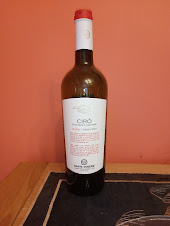3 more obscure grape varieties. Counoise (S. France), Elbling (Mosel) and Kadarka (Hungary). Grape varieties no 224/5/6 in my WIne Century.
All obscure for a reason, but I'm doing this so you dont have to! I wouldn't bother with any of the 3 again, quite frankly.
Counoise is a dark-skinned
wine
grape grown
primarily in the
Rhône
valley region of
France.
Counoise is also grown in California and Washington. Counoise adds a
peppery note and good acidity to a blended red wine, but does not
have much depth of colour or
tannin.
There were 638 hectares (1,580 acres) of Counoise in France in
2000.
Counoise
is one of the grapes allowed into the blend of Châteauneuf-du-Pape
wine. In 2004 only 0.5% of the appellation's area was planted with
Counoise.
Some producers who favour the variety use about 5% of it in their
blends, and those account for most of the plantings. One such
producer is Château
de Beaucastel, which is noted for using all the 13 allowed
varieties.
It appears in this wne from the Wine Society:
Côtes-du-Rhône, Château de Montfaucon 2017
Made from a big blend of Chateauneuf varieties, inculuding
counoise, this exudes warmth and well being! Richly flavoured,
concentrated and long Rhône red that is perfect winter fuel.
Well, its 5th on the list of Grapes in this wine - so less than 5% at best.
Was it any good? - OK. But not great. Better Cotes de Rhone are out there.
Would I buy again? No.
Cadarca or Kadarka or Gamza is a dark-skinned
variety of
grape
used for
red wine.
It has a long history and is popular in
Romania
and
Bulgaria,
where it is known as
Gamza.
It used to be an important constituent of the Hungarian red cuvée
Bull's Blood
of
Eger or
Szekszárd,
but has long been in decline in Hungarian plantations, to be replaced
by
Kékfrankos
and
Portugieser.It is also grown in most other central European and balkan countries
where it is sometimes known as
Cadarca or
Skadarska.
[3]
Cadarca (Kadarka) wine is characterised by full, easily
recognizable taste, deep aroma and dark or medium dark colour.
Kadarka is often used for cuvees
including some of the Egri
Bikavérs, and also for production of table
wines. The best Kadarka is grown in Minis, Romania from 17th
century.
In Bulgaria, Gamza is mostly
cultivated in the northwestern and central northern regions, in the
Danubian
Plain. Until the recent decades, Gamza was the dominant grape
varietal in these Bulgarian regions. The main features of Gamza are a
large yet compact cluster of small, almost spherical grapes, dark
blue to black in colour.
It appears in this wine from the Wine Society:
Áldás Egri Bikavér, St Andrea 2018 - £12.50 Bottle
This Hungarian blend of eight varieties including kékfrankos
(a.k.a. blaufränkisch) and pinot noir is a brilliant expression of
the traditional 'bulls blood' style. Packed with dark-cherry, bitter
chocolate and bramble flavours, with a cedar and bay leaf note on the
finish.
Well, its 6th on the list of Grapes in this wine - so less than 5% at best.
Was it any good? - Not great. Better red wines out there.
Would I buy again? No.
Waitrose Elbling
£6.99
The Waitrose blurb: - Elbling. Mosel
Qualitätswein. This is a truly ancient variety from the Mosel Valley, with
historic family links to Riesling. Zingy, aromatic, and full of
vibrant sherbet, lime and floral flavours, it has been brought back
to the limelight here to show off its zippy refreshing style.
Elbling is a variety of white grape which today is primarily grown in the upstream
parts of the Mosel
region in Germany
and in Luxembour.
The variety has a long history, and used to cover much of Germany's
vineyards from medieval times and was that country's most cultivated
variety until the early 20th century, but has been in decline ever
since. As of 2006, there were 583 hectares (1,440 acres) of Elbling
vineyards in Germany, which made it the country's 23rd most grown
variety of grape. Of that vineyard surface, 575 ha or 98.6% was found
in the Mosel region
In the same year, there were 122.9 hectares (304 acres) of Elbling
grown in Luxembourg.
Was it any good? - Not great. I suspect it went out of fashion as Riesling is better.
Would I buy again? No.









